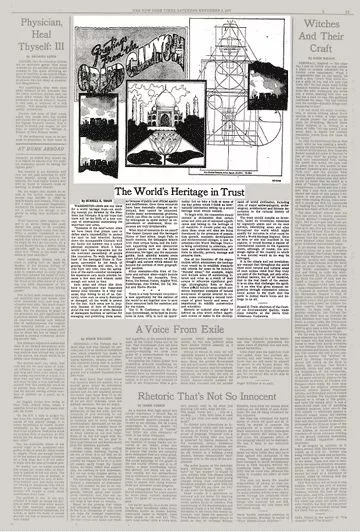研究前沿
托管世界的遗产

托管世界的遗产
引言1971年11月6日,《纽约时报》第31版刊登了一篇文章,题目是《托管世界的遗产》。美国是最早倡导世界遗产公约的国家之一,尼克松总统在任期间,曾致力于全世界共同保护属于全人类的遗产,并促进美国业已成型的国家公园的保护体系在世界范围内的推广。这篇《托管世界的遗产》,便是在这样一个背景下诞生。它的作者是拉塞尔·特兰(June 4, 1920 – September 17, 2012)。他是世界自然基金会的创始人之一,曾任美国环境保护局局长。撰写本文时,特兰的职务是当时刚成立的美国环境质量委员会主席。
通过阅读和品味本文,我们能够回溯世界遗产事业最初的理想,特兰对于即将订立的世界遗产的公约怀有美好的憧憬。他坚信,这份公约将让全世界团结起来,共同保护属于全人类的自然和文化遗产,“为我们自己,更是为世界的将来”。
47年后,让我们一起回顾特兰的梦想。
关于“世界遗产信托”——尼克松总统今年2月提出的令人振奋的概念——我们有如下建议。希望这个全新的国际管理理念能惠泽全世界所有重要的土地。
“土地卫士”,常常被我们用来称呼守护先祖基业的人们。在过去的夏日里,与家人沿着无与伦比的科罗拉多河漂流,使我深刻地感受到如果离开守护者的贡献,我们将无法拥有这般非凡的体验。穿行于坦桑尼亚塞伦盖蒂平原的灌木丛,身处牛羚与斑马群中,仿佛穿越时间,置身于地球的恒春——这又是另一种无与伦比的美丽,它依然仰仗少数守护者的一腔孤勇。
地球上的这些区域所承载的意义远超于其本土利益。本质上讲,它们属于全人类。可以肯定,全世界都会因这些地方遭遇破坏及毁灭而扼腕叹息。现如今,由于对其价值的无知,或管理及保护设备措施的不完善,甚至公众与官方对此的漠视,使这些地方情形告急。这些资源一旦在物质层面遭遇改变或是毁坏,较之通过投资获得提升及改善的环境问题来说,不同的是——它们将去之不返。
那些令我们牵挂的地方,是东非的大峡谷和塞伦盖蒂平原,是南美的安赫尔瀑布,也是孕育珍奇物种的科隆群岛,还是诸如印度犀牛、老虎、山地大猩猩等稀有动物的栖息地。这些壮美的自然环境对科学、思想及文化所产生的影响,都大大突破了其地理范围。
历史和文化方面的案例,则包含金字塔、雅典卫城、特洛伊遗址、佩特拉古城、古罗马广场、吴哥窟、巨石阵、阿布辛贝神庙、泰姬陵和马丘比丘遗址。
振奋人心的时刻已至——让我们抓住这个千载难逢的机遇,团结全世界来共同保护这些资源,为我们自己,更是为世界的将来。
这个机遇是将于1972年6月举行的联合国人类环境会议。我提议,会上应该订立一份国际公约,根据公约建立一个世界遗产信托组织。以下是几点主要建议:
首先,这份公约应包括一份宣言,指出特定区域或地点的普适价值,属全人类所拥有的遗产。公约需要指出,由于这些区域和场所正面临人口增长、经济建设、环境变化所带来的压力与威胁,一个新的组织——世界遗产信托——亟待成立,这个组织将致力于通过国际共同的力量来激励、推动和开展世界遗产的认定、守护、管理及保存事业。
世界遗产信托组织的职责之一是设立遴选标准。比如“自然区域”应该是因其独特或重要的地质、自然地理、动植物方面独特或显著的特征而具有突出意义或价值的区域,包括对于科学研究具有特殊意义的自然生态系统,拥有重要美学价值的自然景观,以及具备野生动植物保护和教育意义的地区。
历史或文化场所,指体现世界文明发展过程中重要事件或阶段的场所,比如人类的文化历史上有重要价值的人类学、考古学、建筑学和历史学意义的场所。
世界遗产信托应该设立一个清单。该清单的基础是建立在缔约国国内遗产普查基础上形成的国家清单。这份清单对全世界范围内的区域和场所进行认定,遴选出具备资格的遗产,命名为——世界遗产名册。一旦一个区域或场所被登录到名册中,对缔约国而言,该遗产将成为全球共同关注的事务。当然,这并不会影响遗产所属国家对于其所拥有的主权。
这是一个简单但具有革命性的概念——在世界范围内存在着一批具有独特价值的自然和文化区域,它们不仅属于个别国家,而是属于全人类所共同拥有——这是这个概念的核心所在,是一种意识的突破。这项事业将通过团结的国际行动证明一个真理,地球是属于全人类共同的家园。

原文
The World's Heritage in Trust
By RUSSELL E. TRAIN NOV. 6, 1971
Here are our ideas for a world heritage trust—an exciting concept put forward by the President last February. It is our hope that there will be the birth of a new concept of international stewardship for important land areas.
“Stewards of the land”—how often we have heard that phrase used to define man's responsibility to protect the land he had inherited. Rafting down the incomparable Colorado with my family last summer was a unique personal experience which I knew would have been impossible but for the dedicated stewardship of people like yourselves. To walk through the bush of the Serengeti Plains in Tanzania, surrounded by the herds of grazing wildebeest and zebra, is to step back into time, into the springtime of the earth—another incomparable experience only made possible because a few men and women cared enough and acted in time.
Such areas and others like them have a significance that transcends merely local interests. In a very real sense, they belong to all of us. Certainly, when such an area is destroyed or damaged, all the world is poorer for the loss. Such areas are in jeopardy because of lack of knowledge about the real values at stake, because of inadequate facilities or services for managing and protecting these areas, or because of public and official apathy and indifference. Once these resources have been materially changed or destroyed, they cannot be recovered. Unlike many environmental problems, which can often be cured or improved by willingness to spend money on improvement or abatement, these resources are truly irreplaceable.
What kind of resources do we mean? The Grand Canyon and the Serengeti Plains of East Africa. Angel. Falls in South America, the Galapagos Islands with their unique fauna, and the habitats supporting rare and spectacular animal species such as the Indian rhinoceros, the tiger, and the mountain gorilla. Such splendid natural areas exert influences on science, on human thought and culture which extend far beyond the confines of their geographical position.
Other examples—this time of, historic and cultural sites—might include, the Pyramids, the Acropolis, Troy, Petra, the Roman Forum, Angkor Wat, Stonehenge, Abu Simbel, the Taj Mahal and Machu Picchu.
There is a very favorable occasion—a rare opportunity for the nations of the world to act together now to save these resources both for ourselves and for the future.
The U. N. Conference on the Human Environment, to be held in Stockholm in June, 1972, is such an opportunity. Let us take a look at some of the key points which I think an international convention setting up a world heritage trust should contain.
To begin with, the convention should contain a declaration that certain areas and sites are of universal significance and belong, to the heritage of all mankind. It should point out that since these areas and sites are being threatened by the pressures of population growth, economic developments and environmental changes, a new institution—the World Heritage Trust—is being established to stimulate, promote and undertake international efforts to identify, protect, manage and preserve them.
One of the functions of the organization which administers the heritage trust would be to establish standards and criteria for areas to be included. “Natural areas,” for example, might well include areas, of outstanding interest and value as a result of their unique or otherwise significant geology, physiography, flora or fauna. These should include areas which constitute important examples of natural ecosystems of special interest to science, areas containing a natural landscape of great beauty and areas of importance to wildlife conservation and education.
Historic or cultural sites might be defined as sites which reflect significant events or states in the development of world civilization, including sites of major anthropological, archeological, architectural and historic importance to the cultural history of mankind.
The trust should compile an inventory, based on inventories submitted by signatory states and on its own surveys, identifying areas and sites throughout the world which might qualify for inclusion in what could be called a World Heritage Register. Once an area or site was inscribed in the register, it would become a matter of international concern to the signatory states, although, of course, the sovereign rights of the country in which it was located would in no way, be infringed.
It is the simple and yet revolutionary concept that throughout the world there exist natural and cultural areas of such unique value that they truly are part of the heritage, not only of individual nations, but of all mankind, that is the real heart of the matter. It is an idea that challenges the spirit. It is an idea that gives eloquent expression through cooperative international action to the truth that the earth is indeed man's home and belongs to us all.
https://www.nytimes.com/1971/11/06/archives/the-worlds-heritage-in-trust.html
翻译:Safin and Mia